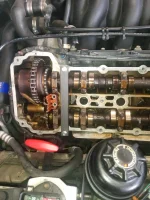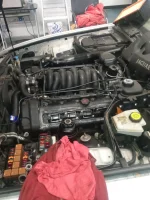Is that the AJ V8? Ford used them in the 00s Thunderbirds and the Lincoln LS. Pretty much everything is obsolete on those from us now. I always cringed when we got calls from people saying that they got a "smoking deal" on a Lincoln LS and then ended up deep in a parts nightmare not realizing it wasn't just a Town Car with better suspension.
You are using an out of date browser. It may not display this or other websites correctly.
You should upgrade or use an alternative browser.
You should upgrade or use an alternative browser.
Broken timing chain in a v8 jaguar
- Thread starter Chris142
- Start date
OVERKILL
$100 Site Donor 2021
Didn't they have some weird hydraulic driven fan or something?Is that the AJ V8? Ford used them in the 00s Thunderbirds and the Lincoln LS. Pretty much everything is obsolete on those from us now. I always cringed when we got calls from people saying that they got a "smoking deal" on a Lincoln LS and then ended up deep in a parts nightmare not realizing it wasn't just a Town Car with better suspension.
Yes they did at one point. I actually just got a call a bit ago from someone "looking to restore a 04 Thunderbird using only factory parts." Everything they wanted was obsolete.Didn't they have some weird hydraulic driven fan or something?
It does have that look, doesn't it? SRAM? Shimano? KMC?High Performance bicycle chain!
What's wrong with the SS worm drive clamps?Do Not get involved in that POS, Some hack's already been in there judging by the blue RTV & the dozen worm drive clamps.
Chris142
Thread starter
Nothing.What's wrong with the SS worm drive clamps?
Chris142
Thread starter
Fortunately the boss knows the situation with this car and I won't be held liable for anything that may go wrong. Nobody else will touch it. I figured I can't make it any worse.I'm also paid hourly not flat rate so I'll work on it all they want. My job is to fix the obvious and no more.When you were a mech in a shop you didn't own did you refuse work?
Learning experience Chris. Do the best you can and have someone sign off on your work for when it comes back.
What's wrong with the SS worm drive clamps?
A couple issues are that they do not maintain constant tension over a range of temperatures, so they can leak particularly if temps get cold. Then people crank them tighter to stop the leak, and usually damage the hose while doing so.
They can also loosen, as the hose can shrink slightly over time.
I prefer constant tension clamps, which come in a variety of styles.
I’ve probably missed the notation, but what model Jag is it ? In 1998-2002 some Jag V-8’s (XK8 & XKR’s) had chain tensioners with plastic backing that failed, often spectacularly. But a chain breaking is something new to me.
I won’t defend poor engineering designs, but the engine used in my ‘02 Jaguar XKR, a 4.0 liter supercharged V-8, can be very reliable, if and only if, the known issue of cam chain tensioners has been dealt with.
The tensioners were replaced on my car during the previous owners tenure @ 115,000 miles. I purchased it right after that and have put another 70,000 miles on it over a six year period. Aside from a leaky oil cooler hose (@ $150), I’ve only had to spend $$$ on consumable items. Which makes it the most reliable used car I’ve purchased. Thanks to a utilizing a little research, I looked for and found a model which had already had the known faults dealt with. Knowing the maintenance history of a prospective used car purchase is the only sensible way to go. Even then, there’s some degree of risk.
It’s my daily driver,which includes 3 or 4 cross country trips yearly. So far, so good. Truthfully, aging electronics are more worrisome to me than mechanical failures.
Z
I won’t defend poor engineering designs, but the engine used in my ‘02 Jaguar XKR, a 4.0 liter supercharged V-8, can be very reliable, if and only if, the known issue of cam chain tensioners has been dealt with.
The tensioners were replaced on my car during the previous owners tenure @ 115,000 miles. I purchased it right after that and have put another 70,000 miles on it over a six year period. Aside from a leaky oil cooler hose (@ $150), I’ve only had to spend $$$ on consumable items. Which makes it the most reliable used car I’ve purchased. Thanks to a utilizing a little research, I looked for and found a model which had already had the known faults dealt with. Knowing the maintenance history of a prospective used car purchase is the only sensible way to go. Even then, there’s some degree of risk.
It’s my daily driver,which includes 3 or 4 cross country trips yearly. So far, so good. Truthfully, aging electronics are more worrisome to me than mechanical failures.
Z
Last edited:
So I have a Volvo Penta V8 engine in my boat. It's a GM 5.7 L block. I see little indication that they have cheapened out anywhere in the build of the engine and all the clamps are SS spiral clamps. I think the constant tension are better but SS spiral are pretty good.A couple issues are that they do not maintain constant tension over a range of temperatures, so they can leak particularly if temps get cold. Then people crank them tighter to stop the leak, and usually damage the hose while doing so.
They can also loosen, as the hose can shrink slightly over time.
I prefer constant tension clamps, which come in a variety of styles.
Obviously the boat is not a cold weather vehicle.
And to think I've been using them for decades with no issue.A couple issues are that they do not maintain constant tension over a range of temperatures, so they can leak particularly if temps get cold. Then people crank them tighter to stop the leak, and usually damage the hose while doing so.
They can also loosen, as the hose can shrink slightly over time.
I prefer constant tension clamps, which come in a variety of styles.
Chris142
Thread starter
Timing tools are in place
Ha ha. In lieu of those “factory” tools the Jag forum typical method of immobilizing the timing gear and chain(s) is to use zip ties. No movement then.
Z
My friend's wife really likes the retro T-birds of that era. I had assumed they had a conventional V8. Perhaps I should warn him off.Is that the AJ V8? Ford used them in the 00s Thunderbirds and the Lincoln LS. Pretty much everything is obsolete on those from us now. I always cringed when we got calls from people saying that they got a "smoking deal" on a Lincoln LS and then ended up deep in a parts nightmare not realizing it wasn't just a Town Car with better suspension.
Had they dropped the 4.6 4V engine in there, heck even the 4.6 3V, the cars would be 10 times better.My friend's wife really likes the retro T-birds of that era. I had assumed they had a conventional V8. Perhaps I should warn him off.
Chris142
Thread starter
they break right after startup usually, out of the dozens i’ve done only a couple bent valves. the plastic pad breaks off and it jams the chain.
new secondary tensioner design has been around since middle of 01. go do the other side and ziptie the chain to the exhaust cam sprocket take the cam caps off lift the cam up and slide the new one in
new secondary tensioner design has been around since middle of 01. go do the other side and ziptie the chain to the exhaust cam sprocket take the cam caps off lift the cam up and slide the new one in
Last edited:
My 2002 Jeep Grand Cherokee with the 4.7 had a hydraulic fan, driven off the power steering pump. The fan never failed but I did have to replace the power steering pump fairly early. Apparently you could drop the electric fan from the 4.0 6 cylinder right in, but you would get a code that couldn't be cleared. Solution in search of a problem definately.Didn't they have some weird hydraulic driven fan or something?
I’m not sure why they chose that design over a traditional clutch fan - maybe it was packaging? but the hydraulic design should in theory have much more cooling capacity than electric. Perhaps a little complex for a passenger vehicle, but I’ve always been intrigued by the setup.My 2002 Jeep Grand Cherokee with the 4.7 had a hydraulic fan, driven off the power steering pump. The fan never failed but I did have to replace the power steering pump fairly early. Apparently you could drop the electric fan from the 4.0 6 cylinder right in, but you would get a code that couldn't be cleared. Solution in search of a problem definately.
I read at the time the engineers figured they had all this extra power being robbed because the power steering pump was simply pushing fluid through a pressure bypass loop all the time, that they might as well use it for something. Other than the PS pump mine didn't give any trouble, but others did have problems with other components.I’m not sure why they chose that design over a traditional clutch fan - maybe it was packaging? but the hydraulic design should in theory have much more cooling capacity than electric. Perhaps a little complex for a passenger vehicle, but I’ve always been intrigued by the setup.
Similar threads
- Replies
- 47
- Views
- 3K
- Replies
- 15
- Views
- 672
- Replies
- 27
- Views
- 546
- Replies
- 30
- Views
- 2K


